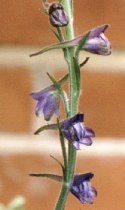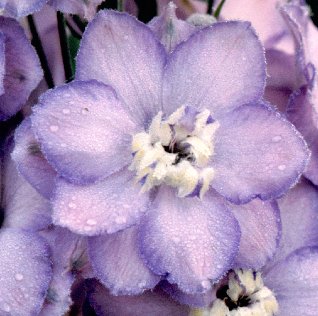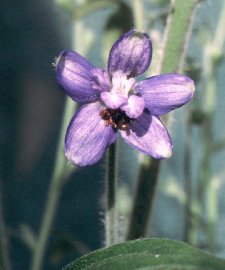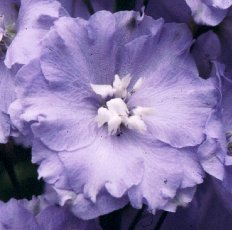 D. pogonanthum from western China has
tubular flowers held close to the stem in a narrow spike.
It does not make an attractive garden plant, partly
because the individual florets are so small but also
because each floret only opens for a day or two. The
sepals drop quickly after pollination so the bloom
consists of just a few open florets with developing seed
pods below and tight buds above.
D. pogonanthum from western China has
tubular flowers held close to the stem in a narrow spike.
It does not make an attractive garden plant, partly
because the individual florets are so small but also
because each floret only opens for a day or two. The
sepals drop quickly after pollination so the bloom
consists of just a few open florets with developing seed
pods below and tight buds above. Despite the failings, looking closely at the sepals shows that the edges of the sepals are more heavily pigmented than the central region, so the flowers could be described as a picotee.

Garden delphinium hybrids with flowers that could be described as picotees arise from time to time. One picotee raised recently is named 'Cher'. The violet picotee shown here has similar colouring to D. pogonanthum but the flowers are five times as large and open wide. The plant was produced by crossing delphinium 'Min', which has strongly patterned violet pigmentation of the sepals, with a pink-tinged white flower, 'Blackberry Ice.
It is interesting to ask why so few gardeners find picotee flowers attractive in delphiniums?

A species with sepals that open wide is D. staphisagria. This biennial flowers in the hot sunshine of the Mediterranean region and is fascinating because the sepals are a drab yellowish green when they first open. The colour develops over several days until the sepals are eventually a deep inky blue.
Interestingly, the spur is just a very short knob and the purple anthers are prominently exposed.

The sepals shown so far all have a neatly curved outline, but in garden hybrid delphiniums serration of the edges and rumpling of the surface are quite common.
These features add interest to the appearance of a flower, as in the case of the fine delphinium 'Gillian Dallas'.